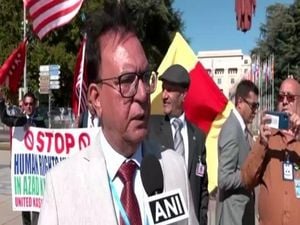Intel, one of the world's best-known chipmakers, has been making headlines lately, not just for its technological advancements, but for the recent departure of its CEO, Pat Gelsinger. This abrupt exit raises numerous questions about the company's future strategies and leadership.
Gelsinger's departure came as somewhat of a shock, especially considering he was only at the helm for about three and a half years. Reports suggest he faced mounting pressure from Intel's board of directors, who grew increasingly frustrated with the pace at which the company was able to turn around its fortunes. The semiconductor industry is notoriously competitive, and for Intel, these pressures have only intensified as rivals like Advanced Micro Devices (AMD) and Nvidia make significant strides.
Under Gelsinger's leadership, Intel attempted to recover its technological edge lost to competitors. His vision primarily focused on maintaining Intel's core operations and striving to become a more significant player as a foundry for external clients. He sought to instill confidence among investors and buyers by promising enhanced production capabilities and advanced offerings.
Unfortunately, the company's earnings did not reflect Gelsinger's ambitions. Reports indicated a series of underwhelming earnings forecasts. It was hardly surprising when corporate observers noted the board's dwindling faith over time. Gelsinger's exit, reported by multiple outlets, is seen as a reset for Intel as it opens up discussions about potential drastic changes—restructuring or even privatization have been topics floated around by insiders.
On the financial side, Gelsinger's exit will come with significant compensation. He is expected to receive approximately $10 million as part of his severance package. Over the years, this has added to the conversation about the golden parachutes often provided to executives, regardless of their performance outcomes.
Following Gelsinger, the immediate question is: who will take the reins next? Intel's board has not finalized its decision, and various candidates are reportedly under consideration. Notable among them is Lip-Bu Tan, who had previously served on Intel's board until last August. Tan is known for being assertive and has been recognized for his leadership roles within the semiconductor space, particularly at Cadence Design Systems.
Tan's strategic approach diverged from Gelsinger’s, especially concerning manufacturing culture and staffing—a sign of the underlying divergences within Intel's executive team prior to Gelsinger's dismissal. Having previously clashed with Gelsinger over several issues, Tan's return to the forefront of Intel's strategy could signal a shift toward more aggressive restructuring, possibly including spinning off parts of Intel's operations.
One avenue to forecast Intel's future success may be through its most significant rival, AMD. Following Gelsinger's ousting, investment guru Jim Cramer suggested AMD could now be viewed as more favorable among investors. “It will just help AMD,” Cramer noted, indicating the potential market opportunities now available to AMD as Intel faces upheaval.
AMD's recent milestones and product innovations string together its rising momentum, largely through AI adoption and broader market engagement. The suggestion here is straightforward: if Intel stumbles, competitors like AMD might just capitalize on those missteps.
The semiconductor industry is witnessing rapid changes driven by technological advancements, making it rare for companies to maintain consistency. For Intel, the departure of Gelsinger serves as both an opportunity and a challenge; will they rebuild under new leadership, or will they face continuing struggles? Analysts and investors alike are watching closely, awaiting news of who will take the helm and whether they can steer Intel back on course.
Yet, the uncertainty doesn’t end with just finding the next CEO. The new leadership will need to navigate the ever-evolving technological territory filled with obstacles. The semiconductor space is currently defined by increased dependencies on external factors including supply chain integrity and geopolitical risks. For Intel, the immediate focus is clear: finding strong leadership is pivotal, but the question remains—can whoever steps up restore faith within the market and consumers quickly enough to counteract AMD's gains?
With new leadership on the horizon, the next few weeks and months will be telling for Intel's direction. Will the next CEO bring stability, or will Intel continue to navigate the stormy seas of corporate restructuring?



